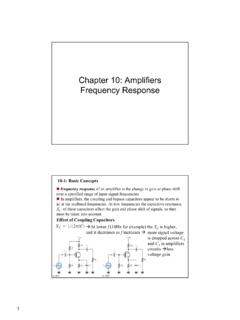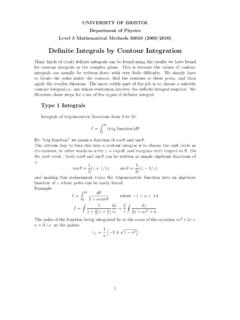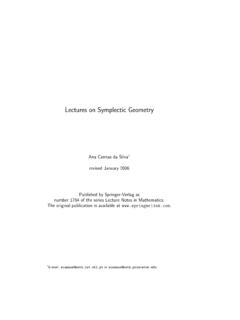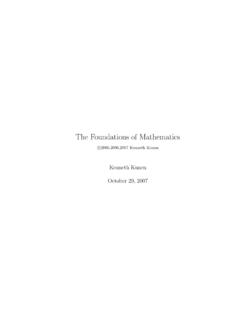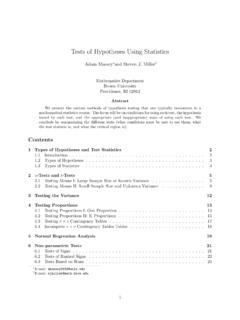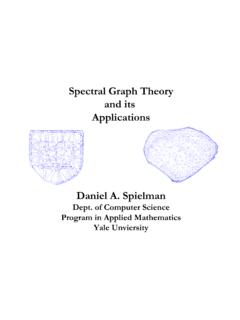Transcription of DIFFERENTIAL SURFACES - فدیکا
1 DIFFERENTIAL GEOMETRYOFCURVES & SURFACESDIFFERENTIAL GEOMETRYOFCURVES & SURFACESR evised & Updated SECOND EDITIONM anfredo P. do CarmoInstituto Nacional de Matem tica Pura e Aplicada (IMPA)Rio de Janeiro, BrazilDOVER PUBLICATIONS, , New YorkCopyrightCopyright 1976, 2016 by Manfredo P. do CarmoAll rights Note DIFFERENTIAL Geometry of Curves and SURFACES : Revised & Updated Second Edition is a revised, corrected, and updated second edition of the work originally published in 1976 by Prentice-Hall, Inc., Englewood Cliffs, New Jersey. The author has also provided a new Preface for this Standard Book NumberISBN-13: 978-0-486-80699-0 ISBN-10: 0-486-80699-5 Manufactured in the United States by LSC Communications80699501 Leny,for her indispensable assistancein all the stages of this bookContentsPreface to the Second Edition xiPreface xiiiSome Remarks on Using this Book xv1. Curves 11-1 Introduction11-2 Parametrized Curves21-3 Regular Curves; Arc Length61-4 The Vector Product in R3121-5 The Local Theory of Curves Parametrized by Arc Length171-6 The Local Canonical Form281-7 Global Properties of Plane Curves312.
2 Regular SURFACES 532-1 Introduction532-2 Regular SURFACES ; Inverse Images of Regular Values542-3 Change of Parameters; Differentiable Functions on Surface722-4 The Tangent Plane; The DIFFERENTIAL of a Map852-5 The First Fundamental Form; Area942-6 Orientation of Surfaces1052-7 A Characterization of Compact Orientable Surfaces1122-8 A Geometric Definition of Area116 Appendix:A Brief Review of Continuity and Differentiability120ixxContents3. The Geometry of the Gauss Map 1363-1 Introduction1363-2 The Definition of the Gauss Map and Its FundamentalProperties1373-3 The Gauss Map in Local Coordinates1553-4 Vector Fields1783-5 Ruled SURFACES and Minimal Surfaces191 Appendix:Self-Adjoint Linear Maps and Quadratic Forms2174. The Intrinsic Geometry of SURFACES 2204-1 Introduction2204-2 Isometries; Conformal Maps2214-3 The Gauss theorem and the Equations of Compatibility2354-4 Parallel Transport. The Gauss-Bonnet theorem and Its Applications2674-6 The Exponential Map.
3 Geodesic Polar Coordinates2874-7 Further Properties of Geodesics; Convex Neighborhoods302 Appendix:Proofs of the Fundamental Theorems of the Local Theory ofCurves and Surfaces3155. Global DIFFERENTIAL Geometry 3215-1 Introduction3215-2 The Rigidity of the Sphere3235-3 Complete SURFACES . theorem of Hopf-Rinow3315-4 First and Second Variations of Arc Length; Bonnet s Theorem3445-5 Jacobi Fields and Conjugate Points3635-6 Covering Spaces; The Theorems of Hadamard3775-7 Global Theorems for Curves: The Fary-Milnor Theorem3965-8 SURFACES of Zero Gaussian Curvature4145-9 Jacobi s Theorems4215-10 Abstract SURFACES ; Further Generalizations4305-11 Hilbert s Theorem451 Appendix:Point-Set Topology of Euclidean Spaces460 Bibliography and Comments 475 Hints and Answers 478 Index 503 Preface to the Second EditionIn this edition, I have included many of the corrections and suggestions kindlysent to me by those who have used the book. For several reasons it is impossibleto mention the names of all the people who generously donated their time doingthat.
4 Here I would like to express my deep appreciation and thank them are also due to John Grafton, Senior Acquisitions Editor at DoverPublications, who believed that the book was still valuable and included in thetext all of the changes I had in mind, and to the editor, James miller , for hispatience with my frequent usual, my wife, Leny A. Cavalcante, participated in the project as if itwas a work of her own; and I might say that without her this volume wouldnot , I would like to thank my son, Manfredo Jr., for helping me withseveral figures in this P. do CarmoSeptember 20, 2016xiPrefaceThis book is an introduction to the DIFFERENTIAL geometry of curves andsurfaces, both in its local and global aspects. The presentation differs from thetraditional ones by a more extensive use of elementary linear algebra and by acertain emphasis placed on basic geometrical facts, rather than on machineryor random have tried to build each chapter of the book around some simple andfundamental idea.
5 Thus, Chapter 2 develops around the concept of a regularsurface inR3; when this concept is properly developed, it is probably the bestmodel for differentiable manifolds. Chapter 3 is built on the Gauss normal mapand contains a large amount of the local geometry of SURFACES inR3. Chapter4 unifies the intrinsic geometry of SURFACES around the concept of covariantderivative; again, our purpose was to prepare the reader for the basic notionof connection in Riemannian geometry. Finally, in Chapter 5, we use thefirst and second variations of arc length to derive some global properties ofsurfaces. Near the end of Cbapter 5 (Sec. 5-10), we show how questions onsurface theory, and the experience of Chapters 2 and 4, lead naturally to theconsideration of differentiable manifolds and Riemannian maintain the proper balance between ideas and facts, we have presenteda large number of examples that are computed in detail. Furthermore, a rea-sonable supply of exercises is provided. Some factual material of classicaldifferential geometry found its place in these exercises.
6 Hints or answers aregiven for the exercises that are prerequisites for reading this book are linear algebra and linear algebra, only the most basic concepts are needed, and a standardundergraduate course on the subject should suffice. From calculus, a cer-tain familiarity with calculus of several variables (including the statementxiiixivPrefaceof the implicit function theorem ) is expected. For the reader s convenience,we have tried to restrict our references to R. C. Buck,Advanced Calcu-lus, New York: McGraw-Hill, 1965 (quoted as Buck,Advanced Calculus).A certain knowledge of DIFFERENTIAL equations will be useful but it is book is a free translation, with additional material, of a book anda set of notes, both published originally in Portuguese. Were it not for theenthusiasm and enormous help of Blaine Lawson, this book would not havecome into part of the translation was done by Leny am also indebted to my colleagues and students at IMPA for their commentsand support.
7 In particular, Elon Lima read part of the Portuguese version andmade valuable Gardner, J rgen Kern, Blaine Lawson, and Nolan Wallach readcritically the English manuscript and helped me to avoid several mistakes, bothin English and Mathematics. Roy Ogawa prepared the computer programs forsome beautiful drawings that appear in the book (Figs. 1-3, 1-8, 1-9, 1-10,1-11, 3-45 and 4-4). Jerry Kazdan devoted his time generously and literallyoffered hundreds of suggestions for the improvement of the manuscript. Thisfinal form of the book has benefited greatly from his advice. To all thesepeople and to Arthur Wester, Editor of Mathematics at Prentice-Hall, andWilson G es at IMPA I extend my sincere de JaneiroManfredo P. do CarmoSome Remarks on UsingThis BookWe tried to prepare this book so it could be used in more than one type ofdifferential geometry course. Each chapter starts with an introduction thatdescribes the material in the chapter and explains how this material will beused later in the book.
8 For the reader s convenience, we have used footnotes topoint out the sections (or parts thereof) that can be omitted on a first there is enough material in the book for a full-year course (ora topics course), we tried to make the book suitable for a first course ondifferential geometry for students with some background in linear algebra andadvanced a short one-quarter course (10 weeks), we suggest the use of thefollowing material: Chapter 1: Secs. 1-2, 1-3, 1-4, 1-5 and one topic ofSec. 1-7 2 weeks. Chapter 2: Secs. 2-2 and 2-3 (omit the proofs), Secs. 2-4and 2-5 3 weeks. Chapter 3: Secs. 3-2 and 3-3 2 weeks. Chapter 4:Secs. 4-2 (omit conformal maps and Exercises 4, 13 18, 20), 4-3 (up to Gausstheorema egregium), 4-4 (u p to Prop. 4; omit Exercises 12, 13, 16, 18 21),4-5 (up to the local Gauss-Bonnet theorem ; include applications (b) and (f)) 3 10-week program above is on a pretty tight schedule. A more relaxedalternativeistoallowmoretimeforth efirstthreechaptersandtopresentsurveylec tures, on the last week of the course, on geodesics, the Gauss theoremaegregium, and the Gauss-Bonnet theorem (geodesics can then be defined ascurves whose osculating planes contain the normals to the surface).
9 XvxviSome Remarks on Using This BookIn a one-semester course, the first alternative could be taught more leisurelyand the instructor could probably include additional material (for instance,Secs. 5-2 and 5-10 (partially), or Secs. 4-6, 5-3 and 5-4).Please also note that an asterisk attached to an exercise does not mean theexercise is either easy or hard. It only means that a solution or hint is providedat the end of the book. Second, we have used for parametrization a bold-facedxand that might become clumsy when writing on the blackboard. Thus wehave reserved the capitalXas a suggested letter symbols that would normally be italic appear in italic context,the letter symbols are set in roman. This has been done to distinguish thesesymbols from the surrounding Curves 1-1. Introduction The DIFFERENTIAL geometry of curves and SURFACES has two aspects. One, which may be called classical DIFFERENTIAL geometry, started with the beginnings of calculus. Roughly speaking, classical DIFFERENTIAL geometry is the study of local properties of curves and SURFACES .
10 By local properties we mean those properties which depend only on the behavior of the curve or surface in the neighborhood of a point. The methods which have shown themselves to be adequate in the study of such properties are the methods of DIFFERENTIAL calculus. Because of this, the curves and SURFACES considered in DIFFERENTIAL geometry will be de fined by functions which can be differentiated a certain number of times. The other aspect is the so-called global DIFFERENTIAL geometry. Here one studies the influence of the local properties on the behavior of the entire curve or surface. We shall come back to this aspect of DIFFERENTIAL geometry later in the book. Perhaps the most interesting and representative part of classical differ-ential geometry is the study of SURFACES . However, some local properties of curves appear naturally while studying SURFACES . We shall therefore use this first chapter for a brief treatment of curves. The chapter has been organized in such a way that a reader interested mostly in SURFACES can read only Sees.
